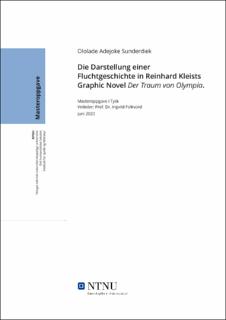| dc.description.abstract | The genre of Graphic Novels has become increasingly popular in the last few years as a literary medium through which serious societal issues are being presented to a reading audience, moving away from an identity as a primarily entertaining form directed mostly at young readers. In the German literary sciences specifically, Graphic Novels have been used to present a range of topics from (auto-) biographical stories of well-known people to stories dealing with migration, the country’s Nazi past as well as stories presenting the experiences of individuals who have been displaced from their home countries for different reasons. Such Graphic Novels have been found to meet with considerable positive reception among its readers.
In this paper, the focus is on discussing and presenting how the literary Genre of Graphic Novels depict escape stories using Reinhard Kleist’s Der Traum von Olympia. Reinhard Kleist is a prolific German Comic author whose 2017 published Graphic Novel Der Traum von Olympia seem to have a struck a chord with its reading audience. Depicting the story of a Somalian refugee fleeing her home country, Kleist presents her escape story in Comic-format.
This work aims to find out how the unique characteristics of the Graphic Novel Genre are harnessed to present a controversial and sensitive issue like Flight and Expulsion in a way that the topic is not reduced to just a cliché and that the reader gains an understanding of the topic beyond media reports. Using the narrative framework of Comics / Graphic Novels, this work will specifically examine how the Genre’s multimodal and semiotic resources contribute to explaining and depicting the issues around Flight to its audience. Furthermore, this work will be considered within the frameworks of Erll and Nünnings Conceptual Memory Theory, in an effort to discuss how Kleist’s Graphic Novel contributes to the memory of refugees in Europe’s cultural memory space. | |
